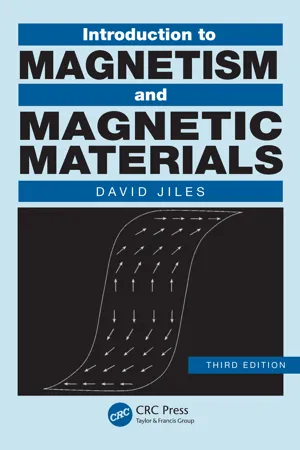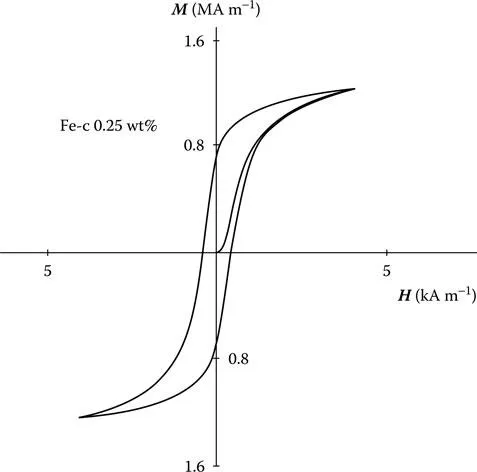
- 626 pages
- English
- ePUB (mobile friendly)
- Available on iOS & Android
eBook - ePub
Introduction to Magnetism and Magnetic Materials
About this book
A long overdue update, this edition of Introduction to Magnetism and Magnetic Materials is a complete revision of its predecessor. While it provides relatively minor updates to the first two sections, the third section contains vast updates to reflect the enormous progress made in applications in the past 15 years, particularly in magnetic recordin
Frequently asked questions
Yes, you can cancel anytime from the Subscription tab in your account settings on the Perlego website. Your subscription will stay active until the end of your current billing period. Learn how to cancel your subscription.
No, books cannot be downloaded as external files, such as PDFs, for use outside of Perlego. However, you can download books within the Perlego app for offline reading on mobile or tablet. Learn more here.
Perlego offers two plans: Essential and Complete
- Essential is ideal for learners and professionals who enjoy exploring a wide range of subjects. Access the Essential Library with 800,000+ trusted titles and best-sellers across business, personal growth, and the humanities. Includes unlimited reading time and Standard Read Aloud voice.
- Complete: Perfect for advanced learners and researchers needing full, unrestricted access. Unlock 1.4M+ books across hundreds of subjects, including academic and specialized titles. The Complete Plan also includes advanced features like Premium Read Aloud and Research Assistant.
We are an online textbook subscription service, where you can get access to an entire online library for less than the price of a single book per month. With over 1 million books across 1000+ topics, we’ve got you covered! Learn more here.
Look out for the read-aloud symbol on your next book to see if you can listen to it. The read-aloud tool reads text aloud for you, highlighting the text as it is being read. You can pause it, speed it up and slow it down. Learn more here.
Yes! You can use the Perlego app on both iOS or Android devices to read anytime, anywhere — even offline. Perfect for commutes or when you’re on the go.
Please note we cannot support devices running on iOS 13 and Android 7 or earlier. Learn more about using the app.
Please note we cannot support devices running on iOS 13 and Android 7 or earlier. Learn more about using the app.
Yes, you can access Introduction to Magnetism and Magnetic Materials by David Jiles in PDF and/or ePUB format, as well as other popular books in Physical Sciences & Condensed Matter. We have over one million books available in our catalogue for you to explore.
Information
Section II
Magnetism in Materials
Magnetic Phenomena on the Microscopic Scale
5 Magnetic Properties
We will now look at the causes of hysteresis in ferromagnets and how the variation of magnetization with magnetic field can be quantified in restricted cases such as at low field and in the approach to saturation. High-resolution measurements of the variation of M with H indicate that there are discontinuities. This is known as the Barkhausen effect. We will also consider the change in length of a ferromagnet as it is magnetized, that is, the magnetostriction, and discuss anisotropy in relation to magnetostriction.
We have shown in the previous chapter that most of the important macroscopic magnetic properties of ferromagnets can be represented on a B-H plot or hysteresis loop. From this, the magnetization can be calculated at every point on the hysteresis curve using the general formula B = μ0(H + M). As the magnetization curve is traversed, there are discontinuous, irreversible changes in the magnetization known as the Barkhausen effect after its discoverer. In recent years, the Barkhausen effect has become an important tool for investigating the microstructural properties of ferromagnetic materials.
One important bulk property of interest, which is not contained in the hysteresis plot, is the magnetostriction. This is the change in length of a material either as a result of a magnetic order (spontaneous magnetostriction) or under the action of a magnetic field (field-induced magnetostriction). This will also be discussed in this chapter.
5.1 HYSTERESIS AND RELATED PROPERTIES
5.1.1 INFORMATION FROM THE HYSTERESIS CURVE
Which are the most important macroscopic magnetic properties of ferromagnets?
From the hysteresis curve such as the one shown in Figure 5.1, we can define a number of magnetic properties of the material, which can be used to characterize the hysteresis loop. A question immediately arises: How many degrees of freedom are there in a hysteresis loop? Or to put the question another way: How many parameters are needed to characterize a hysteresis loop? Clearly, there is no general answer to this, but for the commonly encountered sigmoid-shaped hysteresis loop such as the one in Figure 5.1, we can start to enumerate the important properties and thereby make an estimate.

5.1.2 PARAMETRIC CHARACTERIZATION OF HYSTERESIS
Which are the parameters that can be used to define hysteresis?
First of all, the saturation magnetization M0 will give us an upper limit to the magnetization that can be achieved. At temperatures well below the Curie point, the technical saturation Ms can be used instead. The width of the loop across the H axis, which is twice the coercivity Hc, is also an independent parameter since this can be altered by heat treatment and hence is not dependent on Ms. The height of the curve along the B-axis, that is, the remanence is also an independent parameter since it is not wholly dependent on Ms and Hc. The orientation of the hysteresis curve on the B-H plane, which can be represented by , the slope of the curve at the coercive point, is also independent of the other parameters.
The hysteresis loss WH may also be an independent parameter as may the initial permeability . Finally, the curvature of the sides of the hysteresis loop, which although not immediately obvious as an independent parameter, is clearly not dependent on factors such ...
Table of contents
- Cover
- Half Title
- Title Page
- Copyright Page
- Dedication
- Table of Contents
- Preface
- Acknowledgements
- Glossary of Symbols
- SI Units, Symbols, and Dimensions
- Values of Selected Physical Constants
- Introduction
- Section I Electromagnetism: Magnetic Phenomena on the Macroscopic Scale
- Section II Magnetism in Materials: Magnetic Phenomena on the Microscopic Scale
- Section III Magnetics: Technological Applications
- Solutions to Exercises
- Appendix A
- Appendix B
- Index